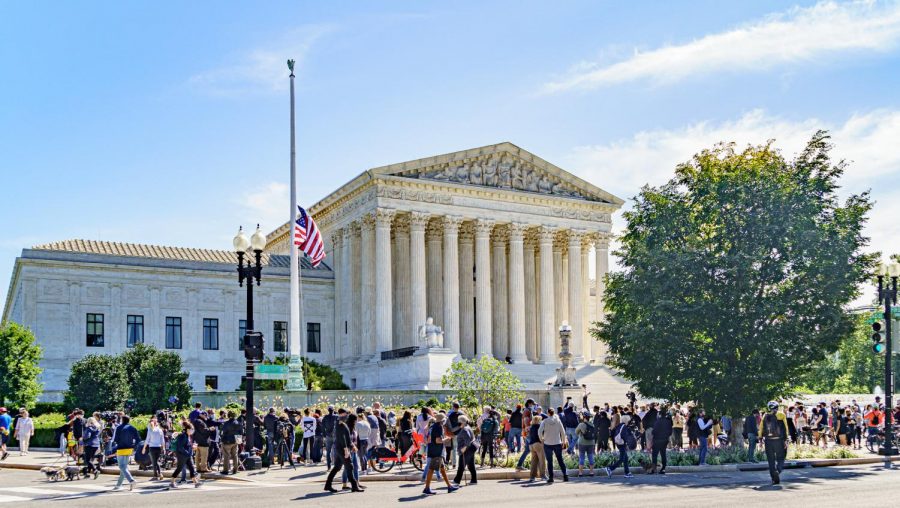Nick Explains: Supreme Court nominations
Mourners at the United States Supreme Court following the death of Ruth Bader Ginsburg
Sep 25, 2020
On Sept. 18, Justice Ruth Bader Ginsburg passed away at the age of 87 due to complications relating to her metastatic pancreatic cancer. Ginsburg was a titan of the left, consistently providing a liberal vote on the U.S. Supreme Court.
Her death leaves the Supreme Court at just eight justices and gives President Donald Trump and the GOP an opportunity to claim a 6-3 conservative majority. This would be a once-in-a-generation chance to establish the most conservative court in modern history.
This is, for Democrats, an absolute nightmare. LGBTQIA+ rights, women’s rights, abortion rights and the Affordable Care Act are all at stake. Supreme Court appointees last for decades, and a stacked court like this would curb any attempt by Democrats to push their policies through.
Is there any hope for Democrats right now, or will the GOP steamroll Ginsburg’s dying wish to “not be replaced until a new president is installed”?, according to NPR.
There are a few obstacles that Republicans have to face in order to nominate and confirm a new justice. The first is time. With just 40 days until the election, it will be difficult for the Senate to push through a candidate, Republican-controlled or not.
According to a September 2018 Congressional Research Service report, since 1975, only two out of 15 Supreme Court nominees have been confirmed in under 40 days: Justice John Paul Stevens under President Gerald Ford and Justice Sandra Day O’Connor under President Ronald Reagan.
Stevens was nominated by Ford after Ford was about to enter an intense election campaign, and he did not want the Supreme Court to be a source of controversy. In response, Ford nominated Stevens, who would be an easy confirmation. According to the New York Times, Stevens passed the heavily Democratic Senate with a vote of 98-0 in 1975, leading to his quick confirmation of only 19 days.
In 1981, O’Connor was confirmed in 33 days as the first female justice, with a vote of 99-0. The Senate that confirmed her looked more like today’s Senate, with 53 Republicans and 47 Democrats. She, however, was viewed as a mostly safe choice for Democrats. She fought for women’s rights and actually ended up voting to uphold Roe v. Wade, acting as a crucial swing vote for abortion rights, despite her conservative background.
Today, it would be hard to imagine Trump nominating a candidate that is less controversial than O’Connor or Stevens. Assuming he nominates someone this Saturday, Senate Republicans will have only 38 days to push through a nominee. Considering that Justice Brett Kavanaugh’s confirmation took 88 days, though plagued with sexual assault allegations, it is hard to imagine one of the most divisive presidents being able to fill the seat before Election Day.
This does, however, bring up speculation over whether or not the president will fill the seat during what is called a “lame-duck” Senate, or a Senate consisting of members who may have been voted out by their constituents on Election Day. In theory, the odds of this happening are minimal, but considering all that 2020 has provided so far, I wouldn’t say it’s out of the question.
Time is not the only obstacle that Republicans will have to face in order to confirm a new justice. Many Republican senators are being tripped by their own words, specifically from 2016, when they prevented former President Barack Obama from filling a Supreme Court seat in the spring of an election year.
Following the death of Justice Antonin Scalia, Obama named Merrick Garland as his nominee to the U.S. Supreme Court. However, mere hours following Scalia’s death, Senate Majority Leader Mitch McConnell said that any appointment by the sitting president was to be null and void, citing the upcoming election. Later, this was dubbed “the Biden Rule,” after former Vice President Biden’s speech in 1992 calling for President Ronald Reagan to wait until after elections to fill Supreme Court vacancies.
Thankfully, some Republicans have followed this precedent, as Sen. Lisa Murkowski of Alaska and Sen. Susan Collins of Maine have both announced that they will wait until after the election to vote for confirmation. With two Republicans out, McConnell can only lose one more vote before losing the majority in this decision. But with some Republican Senators facing tough reelection campaigns, McConnell may run out of “Get out of Jail Free” cards. Considering her last Supreme Court confirmation cost her $4 million, it is no surprise that Sen. Collins withdrew from this decision.
So, where does that leave us?
Republicans most likely do not have the time to fully confirm a nominee, especially considering this president’s poor track record in choosing someone well-liked. Whether they pursue confirmation is a different question, as Republicans recently have not minded being hypocritical. They will most likely try to get a nominee through or, terrifyingly, confirm a justice in a lame-duck Senate.













